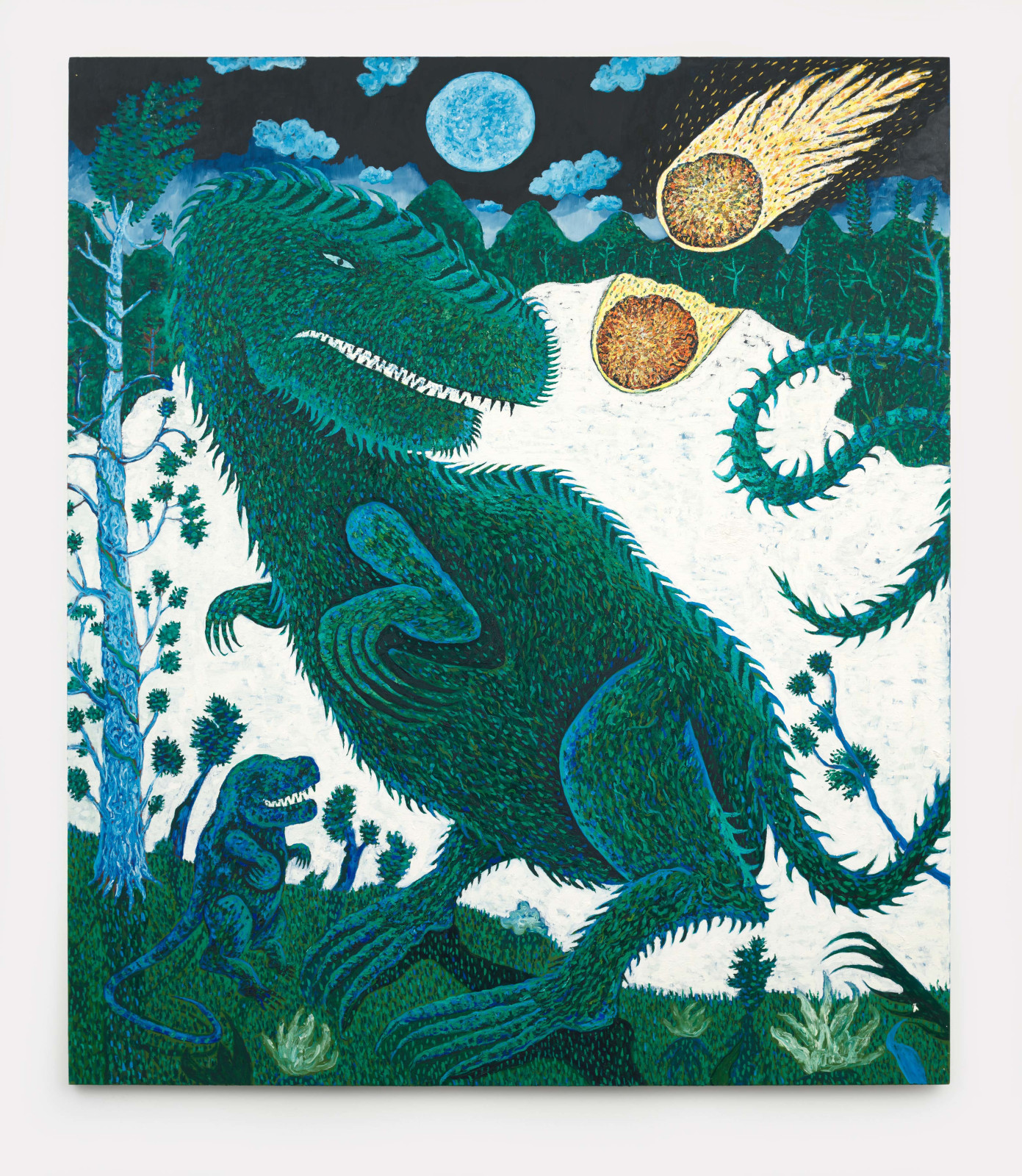
Simchowitz is pleased to present ‘seconds from the end’, the first solo exhibition of the artist Mark Connolly in Los Angeles. Born in Ballymena near Belfast, Ireland in 1991, and currently based in London, Connolly’s medium-to-large oil paintings depict a labyrinthian maze of lush, cool-toned jungles and turbulent seascapes that are both real and imagined. Most are full of lions, leopards, tigers, crocodiles, snakes and other predators, but you will also find sea monsters, dragons, chimeras and devils alike. As the title suggests, these creatures are often shown in mid-battle, sometimes attacking other creatures, or sometimes trapped in a sustained conflict with men, knights, or even the gods themselves. As in most mythological fables, they’re meant to represent good versus evil, the arc of the hero, and the petty foibles of man. And yet for all their phantasmagorical content, they never come off as shrill. They don’t threaten or unnerve or dwell in the bloody. In fact, the battles themselves often remain unresolved, always in media res, which only underscores their function as make-believe and theater. It’s all clearly staged much like contemporary wrestling—a theme that pops up in Connolly’s paintings with some frequency. “I am interested in the question of whether the world is imagined or fictive,” he says. “I‘m constantly chasing paintings that fuse the imagined and the observed, hopefully creating something resembling a new world.”
Aesthetically, there’s an almost textile quality to Connolly’s paintings, especially in the way they rhythmically swirl and dance across the surface, creating an almost patterning effect. They’re also purposefully, yet not in a CoBRA or Art Brut way, but closer to the more controlled, outsider quality of Henri Rousseau—with a purposeful flattening of the image and a combination of disarming innocence and complex storytelling.
As Connolly admits, it’s an unapologetically Romantic vision to be sure, and he often references specific medieval and Renaissance prototypes for inspiration. He transformed Raphael’s painting of St. Michael for instance, which he saw at the Louvre in Paris, into Passing Death and the Devil (2020); and Paolo Uccello’s Saint George and the Dragon, which he saw at the National Gallery in London, into Battle Under a Blood Moon (2020). Then there are the Roman mosaics of tigers and bulls that he saw at the Capitolini Museum in Rome, which he transformed into Tiger Assaulting Bull (2021). “I see some of those narratives as ‘standards,’ much like jazz standards,” he says. “They seem to exist outside of time, yet they reoccur continually through time.”
Connolly’s intertextuality also relates to how his paintings interact within his own practice. His self-portrait, The View from Marchmont (2021) for example, shows him sitting alone in a cramped room, which is entirely bathed in the blueish light of a small television. Look closely and you’ll see a glimpse of David Lynch’s Lost Highway on the screen, which is the moment where the protagonist’s paranoia gets validated once he discovers that someone has been inside his house, recording him with a camera. Connolly complicates that idea by creating a second painting called Tuscan Drive (2021), which was painted entirely from memory and depicts a night drive through a wooded area. Each work feeds the next, while their content finds common ground in their own internal logic and language. “I’m quite interested in that space that happens when you offset certain allusions to reality with pure fiction and vice versa,” he says. “And how that expands and contracts to create a ripple effect, which ultimately contributes to the collective narrative.”
Mark Connolly, (b. 1991, Northern Ireland), studied at Sint Lucas Beeldende Kunst Gent, 2013, Edinburgh College of Art, 2014, and The Royal Drawing School, London, 2017. His work has been shown at the James Freeman Gallery (London), Galerie Wolfsen (Skagen, Denmark), Galerie Droste (Berlin), Everyday Gallery (Antwerp), Wells Projects (London), Eccleston Project Space (London) and The Five Bells (New Cross). His residencies include: Borgo Pigano (Tuscany), Griffin Gallery (London), FoAM Lab (Brussels), and Six Foot Gallery (Glasgow)
